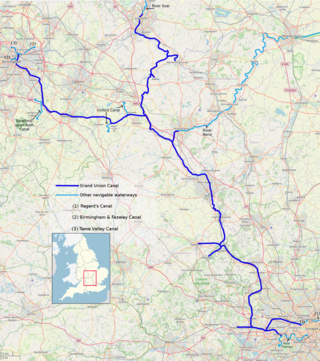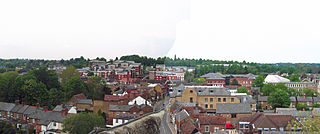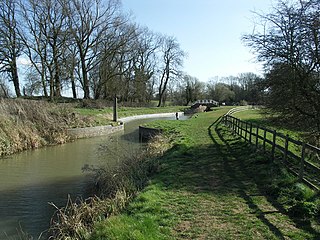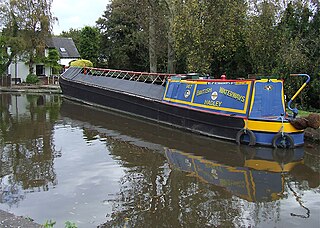Related Research Articles

The Grand Union Canal in England is part of the British canal system. It is the principal navigable waterway between London and the Midlands. Starting in London, one arm runs to Leicester and another ends in Birmingham, with the latter stretching for 137 miles (220 km) with 166 locks from London. The Birmingham line has a number of short branches to places including Slough, Aylesbury, Wendover, and Northampton. The Leicester line has two short arms of its own, to Market Harborough and Welford.

The Birmingham and Fazeley Canal is a canal of the Birmingham Canal Navigations in the West Midlands of England. Its purpose was to provide a link between the Coventry Canal and Birmingham and thereby connect Birmingham to London via the Oxford Canal.

James Brindley was an English engineer. He was born in Tunstead, Derbyshire, and lived much of his life in Leek, Staffordshire, becoming one of the most notable engineers of the 18th century.

Rickmansworth is a town in southwest Hertfordshire, England, about 17 miles (27 km) northwest of central London and inside the perimeter of the M25 motorway. The town is mainly to the north of the Grand Union Canal and the River Colne. The town of Watford is 5 miles (8 km) to the northeast. Rickmansworth is the administrative seat of the Three Rivers District Council. The confluence of the River Chess and the River Gade with the Colne in Rickmansworth inspired the district's name. The enlarged Colne flows south to form a major tributary of the River Thames. The town is served by the Metropolitan line of the London Underground and Chiltern Railways from London Marylebone to Aylesbury railway station.

The Llangollen Canal is a navigable canal crossing the border between England and Wales. The waterway links Llangollen in Denbighshire, north Wales, with Hurleston in south Cheshire, via the town of Ellesmere, Shropshire. The name, which was coined in the 1980s, is a modern designation for parts of the historic Ellesmere Canal and the Llangollen navigable feeder, both of which became part of the Shropshire Union Canals in 1846.
The Grand Western Canal ran between Taunton in Somerset and Tiverton in Devon in the United Kingdom. The canal had its origins in various plans, going back to 1796, to link the Bristol Channel and the English Channel by a canal, bypassing Lands End. An additional purpose of the canal was the supply of limestone and coal to lime kilns along with the removal of the resulting quicklime, which was used as a fertiliser and for building houses. This intended canal-link was never completed as planned, as the coming of the railways removed the need for its existence.

A canal pound, reach, or level, is the stretch of level water impounded between two canal locks. Canal pounds can vary in length from the non-existent, where two or more immediately adjacent locks form a lock staircase, to many kilometres/miles.

The Grand Union Canal was a canal in England from Foxton, Leicestershire on the Leicestershire and Northamptonshire Union Canal to Norton Junction, close to Long Buckby Wharf on the Grand Junction Canal. It now forms the first 23 miles (37 km) of the Leicester line of the Grand Union Canal.

The Watford and Rickmansworth Railway (W&RR) ran services between Watford and Rickmansworth in Hertfordshire, England. The company was incorporated in 1860; the line opened in 1862. The Rickmansworth branch was closed in 1952, and the remaining line was gradually run down and eventually closed in 1996.

The Wendover Arm Canal is part of the Grand Union Canal in England, and forms part of the British canal system. It is usually known as the Wendover Canal, but historically its builders referred to their branch canals as Arms, hence its historical name of Wendover Arm. It was planned as a feeder to carry water from springs near the town of Wendover in Buckinghamshire to the main line of the Grand Junction Canal at Bulbourne near Startops End in Hertfordshire, but when it opened in 1799 it was made navigable, as the extra cost of making it was so small. Water supplies from Wendover were found to be inadequate, and a series of reservoirs were built. A pumping station at Whitehouses was superseded by the Tringford pumping station in 1817; its steam engines were replaced by diesel engines in 1911 and then by electric pumps.

Dapdune Wharf is a former industrial wharf and boat yard on the Wey and Godalming Navigations in Guildford, England, UK, close to the Surrey County Cricket Club ground. It is now maintained by the National Trust.

Batchworth was once a hamlet and is now a civil parish and part of Rickmansworth in Hertfordshire. The parish of Batchworth was created on 1 April 2017 consisting of two Three Rivers District Council wards: Rickmansworth Town, and Moor Park and Eastbury. The first election to Batchworth Parish Council was on 4 May 2017. There are eight councillors; four in each ward.

The Slough Arm is a short canal branch from the Grand Union Main Line to Slough in Berkshire, England. It was originally opened to serve the brick-making industry. The last commercial traffic was carried in 1960, but as the plans to fill it in were opposed locally, the stretch was re-opened in 1975 and has remained in use since.
The Wooden Canal Boat Society (WCBS) is a waterway society and a registered charity in England, UK, based at Ashton-under-Lyne, Greater Manchester. The society started as the Wooden Canal Craft Trust in 1987, and by 1995 the trust owned six boats; it was wound up in 1997, and its assets were handed over to the WCBS.
J. H. Taylor & Sons was an English company that primarily built wooden canal boats on the Shropshire Union Canal at Tower Wharf, Chester. Joseph Harry Taylor set up the business with his son Wilfred in 1914 in the Dee Basin. The company was in Wilfred's name as his father was an undischarged bankrupt. During this time the company built and repaired an array of water craft from traditional Dee skiffs and salmon fishing boats to passenger launches, narrow boats and tugs. Joseph Harry died in 1924 and his sons carried on the business until 1970.

Otter Dock was a branch of the Grand Junction Canal in Yiewsley, Middlesex.

The Bargee is a 1964 British comedy film shot in Techniscope directed by Duncan Wood, and starring Harry H. Corbett, Hugh Griffith, Eric Sykes and Ronnie Barker. The screenplay was written by Ray Galton and Alan Simpson.

Fellows Morton & Clayton Ltd was, for much of the early 20th century, the largest and best-known canal transportation company in England. The company was in existence from 1889 to 1947.

The Grand Union Canal Carrying Company was a freight carrying transport service in England from 1934 to 1948.
Mill End is a suburb of Rickmansworth in Hertfordshire, England. Most of it is an unparished area, not being within a civil parish, although part of the built-up area comes under Chorleywood Parish Council. All of Mill End forms part of Three Rivers District and so is administered by Three Rivers District Council and Hertfordshire County Council.
References
- ↑ "Tributes to Rickmansworth author and historian". Watford Observer.